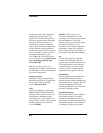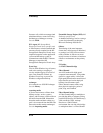
G-9
Glossary
users who are granted the Reporting and
notifications user rights. You can view
or delete all events in the Event Log.
Data Protector user account
You can use Data Protector only if you
have a Data Protector user account,
which restricts unauthorized access to
Data Protector and to backed up data.
Data Protector administrators create this
account specifying a user logon name,
the systems from which the user can log
on, and a Data Protector user group
membership. This is checked whenever
the user starts the Data Protector user
interface or performs specific tasks.
data stream
Sequence of data transferred over the
communication channel.
database library
A Data Protector set of routines that
enables data transfer between Data
Protector and a server of an online
database integration, for example, the
Oracle8/9 Server.
database parallelism
More than one database is backed up at
a time if the number of available devices
allows you to perform backups in
parallel.
database server
A computer with a large database stored
on it, such as the SAP R/3 or Microsoft
SQL database. A server has a database
that can be accessed by clients.
Dbobject (Informix specific term)
An Informix physical database object. It
can be a blobspace, dbspace, or logical-
log file.
DC directory
The Detail Catalog (DC) directory
consists of DC binary files, which store
information about file versions. It
represents the DCBF part of the IDB
occupying approximately 80% of the
IDB. The default DC directory is called
the dcbf directory and is located in the
<Data_Protector_home>\db40
directory. You can create more DC
directories and locate them as
appropriate to you. Up to 10 DC
directories are supported per cell. The
default maximum size of a DC directory
is 2 GB.
DCBF
The Detail Catalog Binary Files (DCBF)
are a part of the IDB. The files in store
information about file versions and
attributes occupying approximately 80%
of the IDB. By default, DCBF consist of
one DC directory with a maximum size
of 2 GB. You can create more DC
directories.


















